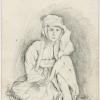‘Bosnian Belle’
Commentary
Page featuring an engraving (made after a drawing by Arthur Evans), captioned ‘Bosnian Belle’, published in Arthur J. Evans, Through Bosnia and the Herzegóvina on Foot during the Insurrection, August and September 1875 (London, 1876), p.148.
Artist: Unidentified engraver, after an original drawing [1941.8.183] by Arthur John Evans
Date of publication: 1876
Continent: Europe
Geographical area: Southern Europe
Country: Bosnia and Herzegovina
Region/Place: Komušina
Cultural group: European Bosnian
Format: Woodcut engraving
Page size: 234 x 141 mm
Acquisition: Henry Balfour. Bequeathed February 1939
***
Research notes: It has been identified by Philip Grover that this woodcut engraving by an unnamed artist was based on an original drawing [1941.8.183] by Arthur John Evans, being the portrait of a young Bosnian woman (‘belle’) seen at the annual fair at the hillside shrine near Komušina. It was published in Evans’ account of his journey, Through Bosnia and the Herzegóvina on Foot during the Insurrection, August and September 1875 (London, 1876), p.148, printed with the caption ‘Bosnian Belle’. Evans recorded in the volume: ‘But another maiden demands my presence, and I am called away to sketch, at her own request, a Bosnian belle, coiffed in the brightest of rosy kerchiefs, enveloped in a jacket with the most gorgeous golden border, and cinctured with a sash of orange and purple. Whether the attitude in which she sat for her portrait was the most elegant she could have chosen, and whether her boots, in which I fancy she took a peculiar pride, were of that form most adapted for displaying maidenly gracility of ankle, may be left for a forbearing public to decide./ Her hair is dark - nor let any ungallantly suggest that its hue is due to artificial causes. Granted that a powder does exist called Kna; let it freely be admitted that the fair Serbs often show themselves as desirous as ladies of the harem to acquire those raven tresses which the Koran distinguishes as a sign of comeliness and strength. But a glance - a scintillation - from those eyes would annihilate any detractor so mean as to bring such imputations against our Bosniac beauty! Here at once, so to speak, we are on terra firma. These at least are incapable of assuming an un-genuine hue; and they are black, black as the sloes with which the national poets delight to compare their mistresses’ orbs, and haloed round with such dark lashes and eyebrows as the same Serbian imagination fondly likens to “leeches from the fountain.” But she was rather the exception in the crowd, and the evident esteem in which her good looks were held was probably more due to this accident of hue than anything else; for if the women’s tresses were sometimes of the fashionable colour, their eyes were oftener of a traitorous turquoise than of jet’: Through Bosnia and the Herzegóvina on Foot, pp.147–149.

